Marine Bioactive Peptides in the Regulation of Inflammatory Responses: Current Trends and Future Directions
Abstract
1. Introduction
Marine Bioactive Peptides (MBPs)
2. The Structure–Function Relationship of Marine Bioactive Peptides
3. Protein Hydrolysis Mechanisms (Protein Hydrolysis, Purification, Separation, and Identification)
3.1. Protein Extraction Process
3.2. Protein Hydrolysis
3.3. Peptide Separation, Purification, Identification, and Quantification Techniques
3.3.1. Ultrafiltration (UF)
3.3.2. Solid Phase Extraction (SPE)
3.3.3. Gel Filtration Chromatography (Size Exclusion)
3.3.4. Ion Exchange
3.3.5. Reverse-Phase High-Performance Liquid Chromatography (RP-HPLC)
3.3.6. Capillary Electrophoresis (CE)
3.3.7. Matrix-Assisted Laser Desorption/Ionization (MALDI) Time-of-Flight (TOF) Mass Spectrometry (MS)
4. Anti-Inflammatory Mediators and Their Therapeutic Potentials
4.1. Anti-Inflammatory Potential of Marine Bioactive Peptides
4.2. Key Mechanisms of the Anti-Inflammatory Mediators
4.2.1. MAPK Inhibition of Marine Organisms
4.2.2. NF-κB Inhibition of Marine Organisms
5. Current Trends and Future Directions
6. Conclusions
Author Contributions
Funding
Data Availability Statement
Acknowledgments
Conflicts of Interest
References
- Jegani, K.T.; Balde, A.; Nazeer, R.A. A review on anti-inflammatory and antioxidant peptides derived from marine organisms: Mechanism of action and therapeutic applications. Food Biosci. 2025, 63, 105745. [Google Scholar] [CrossRef]
- Kim, J.-A.; Kim, S.-K. Bioactive Peptides from Marine Sources as Potential Anti-Inflammatory Therapeutics. Curr. Protein Pept. Sci. 2013, 14, 177–182. [Google Scholar] [CrossRef] [PubMed]
- Shahidi, F.; Saeid, A. Bioactivity of Marine-Derived Peptides and Proteins: A Review. Mar. Drugs 2025, 23, 157. [Google Scholar] [CrossRef] [PubMed]
- Yue, T.; Shi, Y.; Luo, S.; Weng, J.; Wu, Y.; Zheng, X. The role of inflammation in immune system of diabetic retinopathy: Molecular mechanisms, pathogenetic role and therapeutic implications. Front. Immunol. 2022, 13, 1055087. [Google Scholar] [CrossRef]
- Saha, S.; Buttari, B.; Panieri, E.; Profumo, E.; Saso, L. An Overview of Nrf2 Signaling Pathway and Its Role in Inflammation. Molecules 2020, 25, 5474. [Google Scholar] [CrossRef]
- Shin, S.A.; Joo, B.J.; Lee, J.S.; Ryu, G.; Han, M.; Kim, W.Y.; Park, H.H.; Lee, J.H.; Lee, C.S. Phytochemicals as Anti-Inflammatory Agents in Animal Models of Prevalent Inflammatory Diseases. Molecules 2020, 25, 5932. [Google Scholar] [CrossRef]
- Dadar, M.; Shahali, Y.; Chakraborty, S.; Prasad, M.; Tahoori, F.; Tiwari, R.; Dhama, K. Antiinflammatory peptides: Current knowledge and promising prospects. Inflamm. Res. 2019, 68, 125–145. [Google Scholar] [CrossRef]
- Sanjeewa, K.K.A.; Herath, K.; Yang, H.W.; Choi, C.S.; Jeon, Y.J. Anti-Inflammatory Mechanisms of Fucoidans to Treat Inflammatory Diseases: A Review. Mar. Drugs 2021, 19, 678. [Google Scholar] [CrossRef] [PubMed]
- Jogpal, V.; Sanduja, M.; Dutt, R.; Garg, V.; Tinku. Advancement of nanomedicines in chronic inflammatory disorders. Inflammopharmacology 2022, 30, 355–368. [Google Scholar] [CrossRef]
- Placha, D.; Jampilek, J. Chronic Inflammatory Diseases, Anti-Inflammatory Agents and Their Delivery Nanosystems. Pharmaceutics 2021, 13, 64. [Google Scholar] [CrossRef]
- Plichta, J.; Kuna, P.; Panek, M. Biologic drugs in the treatment of chronic inflammatory pulmonary diseases: Recent developments and future perspectives. Front. Immunol. 2023, 14, 1207641. [Google Scholar] [CrossRef]
- Dash, S.; Singh, P.A.; Bajwa, N.; Choudhury, A.; Bisht, P.; Sharma, R. Why Pharmacovigilance of Non-steroidal Anti-inflammatory Drugs is Important in India? Endocr. Metab. Immune Disord. Drug Targets 2024, 24, 731–748. [Google Scholar] [CrossRef] [PubMed]
- Ullah, R.; Khan, I. Biotechnological Utilization of the Marine Environment for Food, Drugs, and Energy. In Marine Biotechnology: Applications in Food, Drugs and Energy; Shah, M.D., Ransangan, J., Venmathi Maran, B.A., Eds.; Springer Nature: Singapore, 2023; pp. 23–46. [Google Scholar]
- Sanjeewa, K. Exploring the Blue Bioeconomy: Marine Bioresources and Sustainable Applications; CRC Press: Boca Raton, FL, USA, 2024. [Google Scholar]
- Senadheera, T.R.L.; Hossain, A.; Shahidi, F. Marine Bioactives and Their Application in the Food Industry: A Review. Appl. Sci. 2023, 13, 12088. [Google Scholar] [CrossRef]
- Tan, L.T. Impact of Marine Chemical Ecology Research on the Discovery and Dev. of New Pharmaceuticals. Mar. Drugs 2023, 21, 174. [Google Scholar] [CrossRef]
- Narayanankutty, A.; Famurewa, A.C.; Oprea, E. Natural Bioactive Compounds and Human Health. Molecules 2024, 29, 3372. [Google Scholar] [CrossRef]
- Moutinho Cabral, I.; Gonçalves, C.; Grosso, A.R.; Costa, P.M. Bioprospecting and marine ‘omics’: Surfing the deep blue sea for novel bioactive proteins and peptides. Front. Mar. Sci. 2024, 11, 1362697. [Google Scholar] [CrossRef]
- Srinivasan, N.; Dhanalakshmi, S.; Pandian, P. Encouraging Leads from Marine Sources for Cancer Therapy A Review Approach. Pharmacogn. J. 2020, 12, 1475–1481. [Google Scholar] [CrossRef]
- Purohit, K.; Reddy, N.; Sunna, A. Exploring the Potential of Bioactive Peptides: From Natural Sources to Therapeutics. Int. J. Mol. Sci. 2024, 25, 1391. [Google Scholar] [CrossRef]
- Gajahin Gamage, N.T.; Miyashita, R.; Takahashi, K.; Asakawa, S.; Senevirathna, J.D.M. Proteomic Applications in Aquatic Environment Studies. Proteomes 2022, 10, 32. [Google Scholar] [CrossRef]
- Forgrave, L.M.; Wang, M.; Yang, D.; DeMarco, M.L. Proteoforms and their expanding role in laboratory medicine. Pract. Lab. Med. 2022, 28, e00260. [Google Scholar] [CrossRef]
- Tang, C.D.; Cheng, J.H.; Sun, D.W. Structure-activity relationships and activity enhancement techniques of marine bioactive peptides (MBPs). Crit. Rev. Food Sci. Nutr. 2024, 65, 4941–4963. [Google Scholar] [CrossRef]
- Cunha, S.A.; Pintado, M.E. Bioactive peptides derived from marine sources: Biological and functional properties. Trends Food Sci. Technol. 2022, 119, 348–370. [Google Scholar] [CrossRef]
- Du, Z.; Li, Y. Review and perspective on bioactive peptides: A roadmap for research, development, and future opportunities. J. Agric. Food Res. 2022, 9, 100353. [Google Scholar] [CrossRef]
- Fernando, I.P.S.; Jayawardena, T.U.; Wu, J. Marine proteins and peptides: Production, biological activities, and potential applications. Food Innov. Adv. 2023, 2, 69–84. [Google Scholar] [CrossRef]
- Wang, L.; Wang, N.; Zhang, W.; Cheng, X.; Yan, Z.; Shao, G.; Wang, X.; Wang, R.; Fu, C. Therapeutic peptides: Current applications and future directions. Signal Transduct. Target. Ther. 2022, 7, 48. [Google Scholar] [CrossRef] [PubMed]
- Bauer, M.; Glowacka, M.; Kamysz, W.; Kleczkowska, P. Marine Peptides: Potential Basic Structures for the Development of Hybrid Compounds as Multitarget Therapeutics for the Treatment of Multifactorial Diseases. Int. J. Mol. Sci. 2024, 25, 12601. [Google Scholar] [CrossRef]
- Izzati, F.; Warsito, M.F.; Bayu, A.; Prasetyoputri, A.; Atikana, A.; Sukmarini, L.; Rahmawati, S.I.; Putra, M.Y. Chemical Diversity and Biological Activity of Secondary Metabolites Isolated from Indonesian Marine Invertebrates. Molecules 2021, 26, 1898. [Google Scholar] [CrossRef] [PubMed]
- Shi, T.; Wang, B.; Zhao, D.-L.; Newman, D.J. Editorial: The discovery, identification and application of marine microorganisms derived natural products. Front. Mar. Sci. 2024, 11, 1366379. [Google Scholar] [CrossRef]
- Dehghani, M.; Taherizadeh, M.R.; Homaei, A. Marine Origin Bioactive Peptides: Novel Advances in the Therapeutic Potential. In Marine Biomaterials; Jana, S., Jana, S., Eds.; Springer Nature: Singapore, 2022; pp. 351–392. [Google Scholar]
- Xu, N.; Peng, X.L.; Li, H.R.; Liu, J.X.; Cheng, J.S.; Qi, X.Y.; Ye, S.J.; Gong, H.L.; Zhao, X.H.; Yu, J.; et al. Marine-Derived Collagen as Biomaterials for Human Health. Front. Nutr. 2021, 8, 702108. [Google Scholar] [CrossRef]
- Ashaolu, T.J.; Pham, B.P.; Molnár, Z.; Varga, L.; Greff, B. The structure–activity relationship of marine peptides: A review. Int. J. Food Sci. Technol. 2024, 59, 4437–4445. [Google Scholar] [CrossRef]
- Sridhar, K.; Inbaraj, B.S.; Chen, B.-H. Recent developments on production, purification and biological activity of marine peptides. Food Res. Int. 2021, 147, 110468. [Google Scholar] [CrossRef] [PubMed]
- El Nashar, H.A.; Kocaeli, S.; Abdallah, M.; El-Shazly, M. Drug from Marine Sampling to Factory. In Marine Ecosystems: A Unique Source of Valuable Bioactive Compounds; Bentham Science: Sharjah, United Arab Emirates, 2023; Volume 3, pp. 355–393. [Google Scholar]
- Sukmarini, L. Drug Development from Peptide-derived Marine Natural Products. IOP Conf. Ser. Mater. Sci. Eng. 2021, 1011, 012063. [Google Scholar] [CrossRef]
- Jin, Q.-H.; Peng, D.-X.; Zheng, Z.-J. Advances in extracting and understanding the bioactivities of marine organism peptides: A review. J. Food Process. Preserv. 2022, 46, e15602. [Google Scholar] [CrossRef]
- Gao, G.; Wang, Y.; Hua, H.; Li, D.; Tang, C. Marine Antitumor Peptide Dolastatin 10: Biological Activity, Structural Modification and Synthetic Chemistry. Mar. Drugs 2021, 19, 363. [Google Scholar] [CrossRef]
- Goel, B.; Jain, S.K. Semisynthesis: Bridging natural products and novel anticancer therapies. Eur. J. Med. Chem. Rep. 2024, 12, 100218. [Google Scholar] [CrossRef]
- Singh, S.B. Discovery and Development of Dolastatin 10-Derived Antibody Drug Conjugate Anticancer Drugs. J. Nat. Prod. 2022, 85, 666–687. [Google Scholar] [CrossRef]
- Trinidad-Calderon, P.A.; Varela-Chinchilla, C.D.; Garcia-Lara, S. Depsipeptides Targeting Tumor Cells: Milestones from In Vitro to Clinical Trials. Molecules 2023, 28, 670. [Google Scholar] [CrossRef] [PubMed]
- Wang, E.; Sorolla, M.A.; Krishnan, P.D.G.; Sorolla, A. From Seabed to Bedside: A Review on Promising Marine Anticancer Compounds. Biomolecules 2020, 10, 248. [Google Scholar] [CrossRef]
- Bojarska, J.; Breza, M.; Remko, M.; Czyz, M.; Gajos-Michniewicz, A.; Zimecki, M.; Kaczmarek, K.; Madura, I.D.; Wojciechowski, J.M.; Wolf, W.M. Structural and Biofunctional Insights into the Cyclo(Pro-Pro-Phe-Phe-) Scaffold from Experimental and In Silico Studies: Melanoma and Beyond. Int. J. Mol. Sci. 2022, 23, 7173. [Google Scholar] [CrossRef] [PubMed]
- Cappello, E.; Nieri, P. From Life in the Sea to the Clinic: The Marine Drugs Approved and under Clinical Trial. Life 2021, 11, 1390. [Google Scholar] [CrossRef]
- Pavlicevic, M.; Maestri, E.; Marmiroli, M. Marine Bioactive Peptides-An Overview of Generation, Structure and Application with a Focus on Food Sources. Mar. Drugs 2020, 18, 424. [Google Scholar] [CrossRef]
- Gagat, P.; Ostrowka, M.; Duda-Madej, A.; Mackiewicz, P. Enhancing Antimicrobial Peptide Activity through Modifications of Charge, Hydrophobicity, and Structure. Int. J. Mol. Sci. 2024, 25, 10821. [Google Scholar] [CrossRef]
- Rivera-Jimenez, J.; Berraquero-Garcia, C.; Perez-Galvez, R.; Garcia-Moreno, P.J.; Espejo-Carpio, F.J.; Guadix, A.; Guadix, E.M. Peptides and protein hydrolysates exhibiting anti-inflammatory activity: Sources, structural features and modulation mechanisms. Food Funct. 2022, 13, 12510–12540. [Google Scholar] [CrossRef]
- Linker, S.M.; Schellhaas, C.; Kamenik, A.S.; Veldhuizen, M.M.; Waibl, F.; Roth, H.-J.; Fouché, M.; Rodde, S.; Riniker, S. Lessons for Oral Bioavailability: How Conformationally Flexible Cyclic Peptides Enter and Cross Lipid Membranes. J. Med. Chem. 2023, 66, 2773–2788. [Google Scholar] [CrossRef]
- Zhang, M.; Sunaba, T.; Sun, Y.; Sasaki, K.; Isoda, H.; Kigoshi, H.; Kita, M. Anti-inflammatory marine cyclic peptide stylissatin A and its derivatives inhibit differentiation of murine preadipocytes. Chem. Commun. 2019, 55, 5471–5474. [Google Scholar] [CrossRef] [PubMed]
- Zheng, C.; Chen, M.; Chen, Y.; Qu, Y.; Shi, W.; Shi, L.; Qiao, Y.; Li, X.; Guo, X.; Wang, L.; et al. Preparation of polysaccharide-based nanoparticles by chitosan and flaxseed gum polyelectrolyte complexation as carriers for bighead carp (Aristichthys nobilis) peptide delivery. Int. J. Biol. Macromol. 2023, 249, 126121. [Google Scholar] [CrossRef]
- Li, Z.; He, Y.; He, H.; Zhou, W.; Li, M.; Lu, A.; Che, T.; Shen, S. Purification identification and function analysis of ACE inhibitory peptide from Ulva prolifera protein. Food Chem. 2023, 401, 134127. [Google Scholar] [CrossRef] [PubMed]
- Je, J.-G.; Kim, H.-S.; Lee, H.-G.; Oh, J.-Y.; Lu, Y.A.; Wang, L.; Rho, S.; Jeon, Y.-J. Low-molecular weight peptides isolated from seahorse (Hippocampus abdominalis) improve vasodilation via inhibition of angiotensin-converting enzyme in vivo and in vitro. Process Biochem. 2020, 95, 30–35. [Google Scholar] [CrossRef]
- Zhang, Y.; He, S.; Rui, X.; Simpson, B.K. Interactions of C. frondosa-derived inhibitory peptides against angiotensin I-converting enzyme (ACE), alpha-amylase and lipase. Food Chem. 2022, 367, 130695. [Google Scholar] [CrossRef]
- Zheng, Y.; Zhang, Y.; San, S. Efficacy of a Novel ACE-Inhibitory Peptide from Sargassum maclurei in Hypertension and Reduction of Intracellular Endothelin-1. Nutrients 2020, 12, 653. [Google Scholar] [CrossRef]
- Hu, Y.D.; Xi, Q.H.; Kong, J.; Zhao, Y.Q.; Chi, C.F.; Wang, B. Angiotensin-I-Converting Enzyme (ACE)-Inhibitory Peptides from the Collagens of Monkfish (Lophius litulon) Swim Bladders: Isolation, Characterization, Molecular Docking Analysis and Activity Evaluation. Mar. Drugs 2023, 21, 516. [Google Scholar] [CrossRef] [PubMed]
- Bi, J.; Tian, C.; Jiang, J.; Zhang, G.L.; Hao, H.; Hou, H.M. Antibacterial Activity and Potential Application in Food Packaging of Peptides Derived from Turbot Viscera Hydrolysate. J. Agric. Food Chem. 2020, 68, 9968–9977. [Google Scholar] [CrossRef]
- Wang, X.; Yu, H.; Xing, R.; Li, P. Characterization, Preparation, and Purification of Marine Bioactive Peptides. BioMed Res. Int. 2017, 2017, 9746720. [Google Scholar] [CrossRef] [PubMed]
- Guadalupi, L.S.; Bianco, M.; Cataldi, T.R.I.; Ravnsborg, T.; Jensen, O.N.; Calvano, C.D. Ultrasound-assisted protein extraction for deep proteome analysis of Spirulina and Chlorella microalgae. LWT 2025, 222, 117647. [Google Scholar] [CrossRef]
- Moreira, C.; Ferreira-Santos, P.; Nunes, R.; Carvalho, B.; Pereira, H.; Teixeira, J.A.; Rocha, C.M.R. Influence of different processing techniques on microalgal protein extraction. Algal Res. 2025, 86, 103958. [Google Scholar] [CrossRef]
- Ahmad, M.I.; Li, Y.; Pan, J.; Liu, F.; Dai, H.; Fu, Y.; Huang, T.; Farooq, S.; Zhang, H. Collagen and gelatin: Structure, properties, and applications in food industry. Int. J. Biol. Macromol. 2024, 254, 128037. [Google Scholar] [CrossRef]
- Gallego, C.; Rodil, E.; Rodríguez, H.; Soto, A. Extraction and characterisation of gelatine from yellowfin tuna skin pretreated with a eutectic solvent. Food Hydrocoll. 2025, 159, 110652. [Google Scholar] [CrossRef]
- Zhang, W.; Boateng, I.D.; Xu, J. Novel marine proteins as a global protein supply and human nutrition: Extraction, bioactivities, potential applications, safety assessment, and deodorization technologies. Trends Food Sci. Technol. 2024, 143, 104283. [Google Scholar] [CrossRef]
- Trigo, J.P.; Steinhagen, S.; Stedt, K.; Krona, A.; Verhagen, S.; Pavia, H.; Abdollahi, M.; Undeland, I. A new method for protein extraction from sea lettuce (Ulva fenestrata) via surfactants and alkaline aqueous solutions. Food Chem. 2025, 464, 141839. [Google Scholar] [CrossRef]
- Farooq, S.; Ahmad, M.I.; Zheng, S.; Ali, U.; Li, Y.; Shixiu, C.; Zhang, H. A review on marine collagen: Sources, extraction methods, colloids properties, and food applications. Collagen Leather 2024, 6, 11. [Google Scholar] [CrossRef]
- Gonzaga, L.J.; Pérez Roa, M.E.; Lavecchia, R.; Zuorro, A. Unlocking marine potential: Microwave-assisted extraction of bioactive compounds from marine macroalgae. J. Environ. Chem. Eng. 2025, 13, 116858. [Google Scholar] [CrossRef]
- Gutierrez-Canul, C.D.; Can-Herrera, L.A.; Ramirez-Rivera, E.J.; Prinyawiwatkul, W.; Sauri-Duch, E.; Moo-Huchin, V.M.; Hernandez-Nunez, E. A Review of Classical and Rising Approaches the Extraction and Utilization of Marine Collagen. BioTech 2025, 14, 26. [Google Scholar] [CrossRef]
- Pasarin, D.; Lavric, V.; Enascuta, C.E.; Ghizdareanu, A.-I.; Matei, C.B. Optimal Enzymatic Hydrolysis of Sweet Lupine Protein towards Food Ingredients. Fermentation 2023, 9, 203. [Google Scholar] [CrossRef]
- Vaishnav, A.; Lal, J.; Mehta, N.K.; Mohanty, S.; Yadav, K.K.; Priyadarshini, M.B.; Debbarma, P.; Singh, N.S.; Pati, B.K.; Singh, S.K. Unlocking the potential of fishery waste: Exploring diverse applications of fish protein hydrolysates in food and nonfood sectors. Environ. Sci. Pollut. Res. Int. 2025, 1–45. [Google Scholar] [CrossRef] [PubMed]
- Marinou, D.; Jacobsen, C.; Odelli, D.; Sarigiannidou, K.; Sorensen, A.M. Production of Protein Hydrolysates from Cod Backbone Using Selected Enzymes: Evaluation of Antioxidative and Antimicrobial Activities of Hydrolysates. Mar. Drugs 2025, 23, 125. [Google Scholar] [CrossRef] [PubMed]
- Jayawardhana, H.; Liyanage, N.M.; Nagahawatta, D.P.; Lee, H.G.; Jeon, Y.J.; Kang, S.I. Pepsin Hydrolysate from Surimi Industry-Related Olive Flounder Head Byproducts Attenuates LPS-Induced Inflammation and Oxidative Stress in RAW 264.7 Macrophages and In Vivo Zebrafish Model. Mar. Drugs 2023, 22, 24. [Google Scholar] [CrossRef]
- Chai, H.; Bo, Y.; Zhou, L.; Talab, A.S.; Zhang, L.; Wang, Y.; Wang, C.; Zhang, T. Protein enzymatic hydrolysates of sea cucumber intestine promotes proliferation and migration of bone marrow mesenchymal stem cells through up-regulating the PI3K/AKT and JAK/STAT pathways. Food Biosci. 2025, 63, 105690. [Google Scholar] [CrossRef]
- Saiwong, S.; Autsavapromporn, N.; Siriwoharn, T.; Techapun, C.; Wangtueai, S. Enzymatic Hydrolysis Optimization for Preparation of Sea Cucumber (Holothuria scabra) Hydrolysate with an Antiproliferative Effect on the HepG2 Liver Cancer Cell Line and Antioxidant Properties. Int. J. Mol. Sci. 2023, 24, 9491. [Google Scholar] [CrossRef]
- Nemati, M.; Shahosseini, S.R.; Ariaii, P. Review of fish protein hydrolysates: Production methods, antioxidant and antimicrobial activity and nanoencapsulation. Food Sci. Biotechnol. 2024, 33, 1789–1803. [Google Scholar] [CrossRef]
- Dobrowolski, A.; Nawijn, W.; Mironczuk, A.M. Brown seaweed hydrolysate as a promising growth substrate for biomass and lipid synthesis of the yeast yarrowia lipolytica. Front. Bioeng. Biotechnol. 2022, 10, 944228. [Google Scholar] [CrossRef] [PubMed]
- Wijethunga, A.M.; He, Q.S.; Prithiviraj, B.; Sun, X. Acid hydrolysis and microwave digestion enhanced protein extraction from red seaweed Palmaria palmata. Food Chem. X 2025, 25, 102222. [Google Scholar] [CrossRef]
- Trubetskaya, A.; Lê, H.Q.; Leppiniemi, J.; Koso, T.; Välisalmi, T.; Linder, M.B.; Pisano, I.; Dou, J.; Leahy, J.J.; Kontturi, E. Microwave hydrolysis, as a sustainable approach in the processing of seaweed for protein and nanocellulose management. Algal Res. 2024, 78, 103406. [Google Scholar] [CrossRef]
- Peng, Z.; Gao, J.; Su, W.; Cao, W.; Zhu, G.; Qin, X.; Zhang, C.; Qi, Y. Purification and Identification of Peptides from Oyster (Crassostrea hongkongensis) Protein Enzymatic Hydrolysates and Their Anti-Skin Photoaging Effects on UVB-Irradiated HaCaT Cells. Mar. Drugs 2022, 20, 749. [Google Scholar] [CrossRef]
- Alavi, F.; Ciftci, O.N. Purification and fractionation of bioactive peptides through membrane filtration: A critical and application review. Trends Food Sci. Technol. 2023, 131, 118–128. [Google Scholar] [CrossRef]
- Bugyi, F.; Toth, G.; Kovacs, K.B.; Drahos, L.; Turiak, L. Comparison of solid-phase extraction methods for efficient purification of phosphopeptides with low sample amounts. J. Chromatogr. A 2022, 1685, 463597. [Google Scholar] [CrossRef]
- Kummari, R.; Bose, K. Gel Filtration Chromatography. In Textbook on Cloning, Expression and Purification of Recombinant Proteins; Bose, K., Ed.; Springer Nature: Singapore, 2022; pp. 199–219. [Google Scholar]
- Saraiva, M.A. Interpretation of α-synuclein UV absorption spectra in the peptide bond and the aromatic regions. J. Photochem. Photobiol. B Biol. 2020, 212, 112022. [Google Scholar] [CrossRef]
- Pandeswari, P.B.; Sabareesh, V. An ESI Q-TOF study to understand the impact of arginine on CID MS/MS characteristics of polypeptides. Int. J. Mass. Spectrom. 2021, 459, 116453. [Google Scholar] [CrossRef]
- Duan, H.; Liu, G.; Liu, J.; Chang, X.; Bao, S.; Song, W.; Yan, W. Research progress on active peptides in marine fish. Food Sci. Anim. Prod. 2024, 2, 9240063. [Google Scholar] [CrossRef]
- Kwon, J.; Shin, D.; Park, G.W.; Lee, G.; Lee, E.; Kang, H.-S. A comprehensive quantitative LC-MS/MS method for rapid gelatin source identification in food products: Comparison with PCR. Food Res. Int. 2025, 201, 115611. [Google Scholar] [CrossRef]
- Al Musaimi, O.; Jaradat, D.s.M.M. Advances in Therapeutic Peptides Separation and Purification. Separations 2024, 11, 233. [Google Scholar] [CrossRef]
- Liu, J.-K. Natural products in cosmetics. Nat. Prod. Bioprospecting 2022, 12, 40. [Google Scholar] [CrossRef]
- Hwang, D.; Kang, M.-j.; Jo, M.J.; Seo, Y.B.; Park, N.G.; Kim, G.-D. Anti-Inflammatory Activity of β-thymosin Peptide Derived from Pacific Oyster (Crassostrea gigas) on NO and PGE2 Production by Down-Regulating NF-κB in LPS-Induced RAW264.7 Macrophage Cells. Mar. Drugs 2019, 17, 129. [Google Scholar] [CrossRef]
- Ahn, C.B.; Cho, Y.S.; Je, J.Y. Purification and anti-inflammatory action of tripeptide from salmon pectoral fin byproduct protein hydrolysate. Food Chem. 2015, 168, 151–156. [Google Scholar] [CrossRef] [PubMed]
- Cermeño, M.; Kleekayai, T.; Amigo-Benavent, M.; Harnedy-Rothwell, P.; FitzGerald, R.J. Current knowledge on the extraction, purification, identification, and validation of bioactive peptides from seaweed. Electrophoresis 2020, 41, 1694–1717. [Google Scholar] [CrossRef] [PubMed]
- Zheng, L.; Yi, Y.; Liu, J.; Lin, X.; Yang, K.; Lv, M.; Zhou, X.; Hao, J.; Liu, J.; Zheng, Y.; et al. Isolation and characterization of marine Brevibacillus sp. S-1 collected from South China Sea and a novel antitumor peptide produced by the strain. PLoS ONE 2014, 9, e111270. [Google Scholar]
- Do, T.; Guran, R.; Adam, V.; Zitka, O. Use of MALDI-TOF mass spectrometry for virus identification: A review. Analyst 2022, 147, 3131–3154. [Google Scholar] [CrossRef]
- Furuta, T.; Miyabe, Y.; Yasui, H.; Kinoshita, Y.; Kishimura, H. Angiotensin I Converting Enzyme Inhibitory Peptides Derived from Phycobiliproteins of Dulse Palmaria palmata. Mar. Drugs 2016, 14, 32. [Google Scholar] [CrossRef]
- Wang, S.; Lei, B.; Zhang, E.; Gong, P.; Gu, J.; He, L.; Han, L.; Yuan, Z. Targeted Therapy for Inflammatory Diseases with Mesenchymal Stem Cells and Their Derived Exosomes: From Basic to Clinics. Int. J. Nanomed. 2022, 17, 1757–1781. [Google Scholar] [CrossRef]
- Zotova, N.; Zhuravleva, Y.; Chereshnev, V.; Gusev, E. Acute and Chronic Systemic Inflammation: Features and Differences in the Pathogenesis, and Integral Criteria for Verification and Differentiation. Int. J. Mol. Sci. 2023, 24, 1144. [Google Scholar] [CrossRef]
- Sugihara, K.; Nishizawa-Higashi, M.; Joe, G.-H.; Onishi, Y.; Shimizu, Y.; Saeki, H. Improvement of anti-inflammatory activity of salmon muscle peptides by conjugation with alginate oligosaccharide and recovery of the active fraction using ampholyte-free isoelectric focusing. Fish. Sci. 2021, 87, 569–577. [Google Scholar] [CrossRef]
- Michel, P.; Wajs-Bonikowska, A.; Magiera, A.; Wosiak, A.; Balcerczak, E.; Czerwinska, M.E.; Olszewska, M.A. Anti-Inflammatory and Antioxidant Effects of (6S,9R)-Vomifoliol from Gaultheria procumbens L.: In Vitro and Ex Vivo Study in Human Immune Cell Models. Int. J. Mol. Sci. 2025, 26, 1571. [Google Scholar] [CrossRef]
- Jo, C.; Khan, F.F.; Khan, M.I.; Iqbal, J. Marine bioactive peptides: Types, structures, and physiological functions. Food Rev. Int. 2017, 33, 44–61. [Google Scholar] [CrossRef]
- Farahani, A.; Farahani, A.; Kashfi, K.; Ghasemi, A. Inducible nitric oxide synthase (iNOS): More than an inducible enzyme? Rethinking the classification of NOS isoforms. Pharmacol. Res. 2025, 216, 107781. [Google Scholar] [CrossRef]
- Jin, J.; Wang, W.; Fan, D.; Hao, Q.; Jia, W. Emerging Roles of Mitogen-Activated Protein Kinase Signaling Pathways in the Regulation of Fruit Ripening and Postharvest Quality. Int. J. Mol. Sci. 2024, 25, 2831. [Google Scholar] [CrossRef] [PubMed]
- Park, H.B.; Baek, K.H. E3 ligases and deubiquitinating enzymes regulating the MAPK signaling pathway in cancers. Biochim. Biophys. Acta Rev. Cancer 2022, 1877, 188736. [Google Scholar] [CrossRef]
- Hu, X.; Liu, J.; Li, J.; Song, Y.; Chen, S.; Zhou, S.; Yang, X. Preparation, purification, and identification of novel antioxidant peptides derived from Gracilariopsis lemaneiformis protein hydrolysates. Front. Nutr. 2022, 9, 971419. [Google Scholar] [CrossRef]
- Zhu, J.; Fan, J.; Xia, Y.; Wang, H.; Li, Y.; Feng, Z.; Fu, C. Potential therapeutic targets of macrophages in inhibiting immune damage and fibrotic processes in musculoskeletal diseases. Front. Immunol. 2023, 14, 1219487. [Google Scholar] [CrossRef] [PubMed]
- Zhan, Y.; Wang, Y.; Li, K.; Song, J.; Chang, Y. A novel p38 MAPK gene in the sea cucumber Apostichopus japonicus (Ajp38) is associated with the immune response to pathogenic challenge. Fish. Shellfish. Immunol. 2018, 81, 250–259. [Google Scholar] [CrossRef]
- Ghallab, D.S.; Ibrahim, R.S.; Mohyeldin, M.M.; Shawky, E. Marine algae: A treasure trove of bioactive anti-inflammatory compounds. Mar. Pollut. Bull. 2024, 199, 116023. [Google Scholar] [CrossRef]
- Herath, K.H.I.N.M.; Nagahawatta, D.P.; Wang, L.; Sanjeewa, K.K.A. The Role of Phlorotannins to Treat Inflammatory Diseases. Chemistry 2025, 7, 77. [Google Scholar] [CrossRef]
- Guo, Q.; Jin, Y.; Chen, X.; Ye, X.; Shen, X.; Lin, M.; Zeng, C.; Zhou, T.; Zhang, J. NF-κB in biology and targeted therapy: New insights and translational implications. Signal Transduct. Target. Ther. 2024, 9, 53. [Google Scholar] [CrossRef]
- Ghiasi, M. Investigating the NF-kappaB signaling pathway in heart failure: Exploring potential therapeutic approaches. Heliyon 2024, 10, e40812. [Google Scholar] [CrossRef]
- Feng, J.; Wang, H.; Luo, X.; Zhang, L.; Zhou, P. Identification and molecular mechanism of the anti-inflammatory effect of sea cucumber peptides: Network pharmacology, molecular docking and animal experiments. Int. J. Biol. Macromol. 2024, 279, 134958. [Google Scholar] [CrossRef] [PubMed]
- Romero-Gallardo, S.; López-Rocha, J.A.; Rosas, C.; Solís-Marín, F.A.; Olvera-Novoa, M.A. Movement and effectiveness of shelters for restocking of the sea cucumber Isostichopus badionotus. Aquac. Rep. 2024, 37, 102191. [Google Scholar] [CrossRef]
- Zhang, J.; Zhang, R.; Li, W.; Ma, X.C.; Qiu, F.; Sun, C.P. IkappaB kinase beta (IKKbeta): Structure, transduction mechanism, biological function, and discovery of its inhibitors. Int. J. Biol. Sci. 2023, 19, 4181–4203. [Google Scholar] [CrossRef]
- Kaminska, P.; Tempes, A.; Scholz, E.; Malik, A.R. Cytokines on the way to secretion. Cytokine Growth Factor. Rev. 2024, 79, 52–65. [Google Scholar] [CrossRef]
- Kwon, Y.J.; Kwon, H.H.; Leem, J.; Jang, Y.Y. Kahweol Inhibits Pro-Inflammatory Cytokines and Chemokines in Tumor Necrosis Factor-alpha/Interferon-gamma-Stimulated Human Keratinocyte HaCaT Cells. Curr. Issues Mol. Biol. 2024, 46, 3470–3483. [Google Scholar] [CrossRef]
- Ahmed, I.; Asgher, M.; Sher, F.; Hussain, S.M.; Nazish, N.; Joshi, N.; Sharma, A.; Parra-Saldivar, R.; Bilal, M.; Iqbal, H.M.N. Exploring Marine as a Rich Source of Bioactive Peptides: Challenges and Opportunities from Marine Pharmacology. Mar. Drugs 2022, 20, 208. [Google Scholar] [CrossRef] [PubMed]
- Sharma, A.; Baraiya, R.; Prakash, S.; Biswas, A.; Chowdhury, B.; Sharma, A. Anti-Inflammatory Potential of Fish-Derived Bioactive Peptides: Molecular Mechanisms, Delivery Strategies, and Clinical Perspectives. Compr. Rev. Food Sci. Food Saf. 2025, 24, e70234. [Google Scholar] [CrossRef] [PubMed]
- Abdo, A.A.A.; Al-Dalali, S.; Hou, Y.; Aleryani, H.; Shehzad, Q.; Asawmahi, O.; Al-Farga, A.; Mohammed, B.; Liu, X.; Sang, Y. Modification of Marine Bioactive Peptides: Strategy to Improve the Biological Activity, Stability, and Taste Properties. Food Bioprocess. Technol. 2024, 17, 1412–1433. [Google Scholar] [CrossRef]
- Zhang, Y.; Luo, M.; Wu, P.; Wu, S.; Lee, T.Y.; Bai, C. Application of Computational Biology and Artificial Intelligence in Drug Design. Int. J. Mol. Sci. 2022, 23, 13568. [Google Scholar] [CrossRef] [PubMed]
- Zhai, S.; Liu, T.; Lin, S.; Li, D.; Liu, H.; Yao, X.; Hou, T. Artificial intelligence in peptide-based drug design. Drug Discov. Today 2025, 30, 104300. [Google Scholar] [CrossRef] [PubMed]
- Han, M.; Liu, K.; Liu, X.; Rashid, M.T.; Zhang, H.; Wang, M. Research Progress of Protein-Based Bioactive Substance Nanoparticles. Foods 2023, 12, 2999. [Google Scholar] [CrossRef] [PubMed]
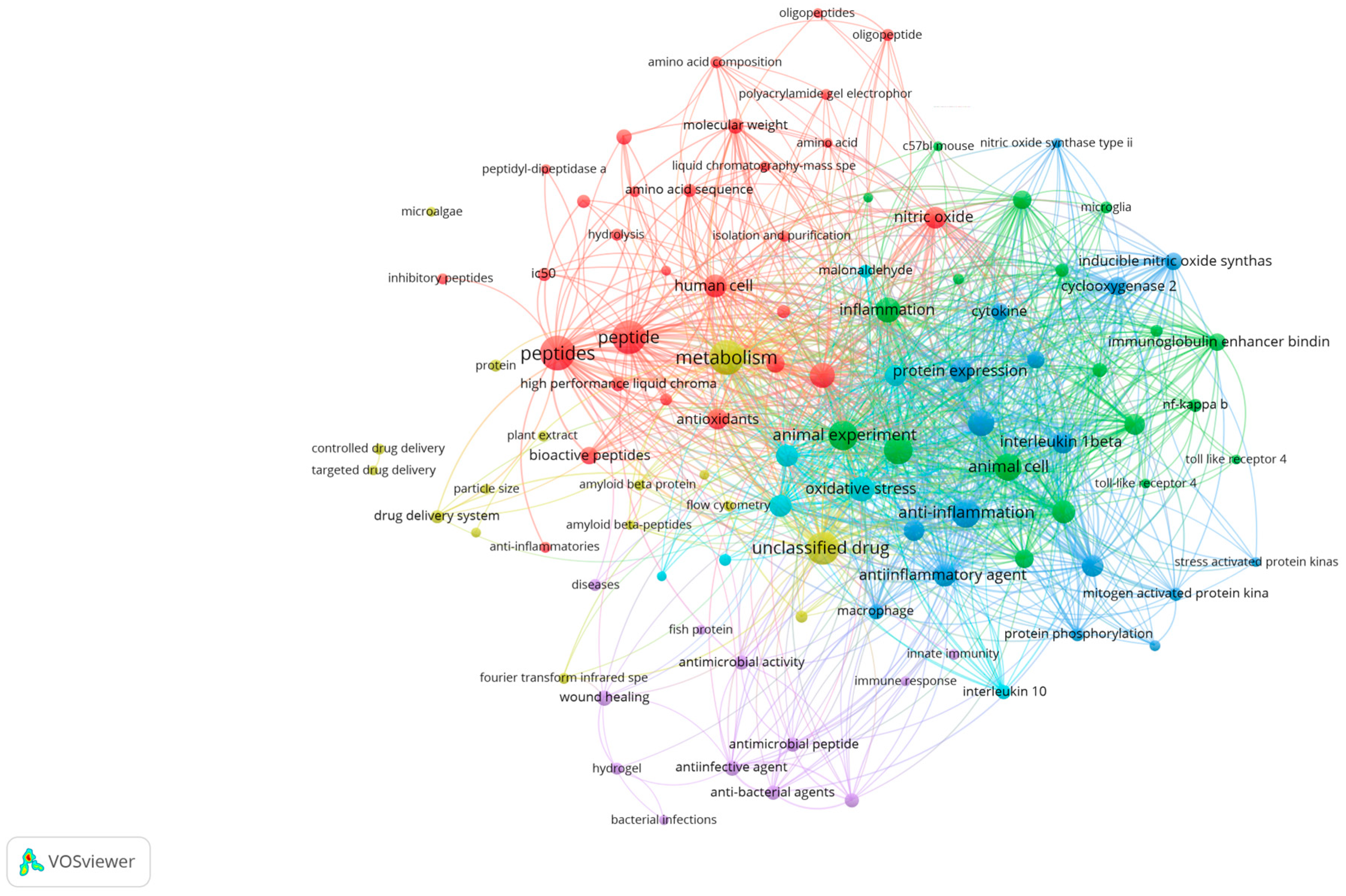
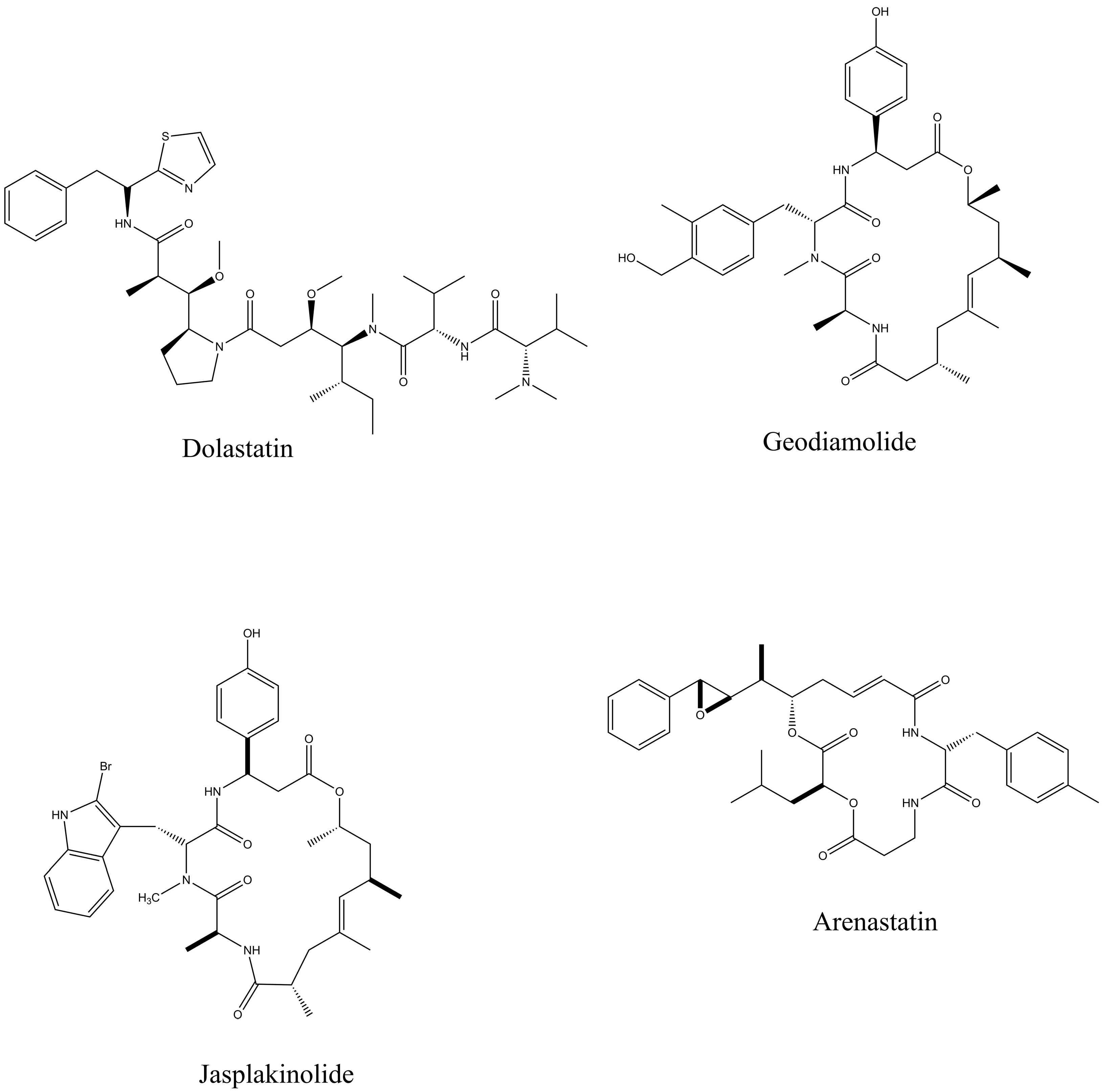
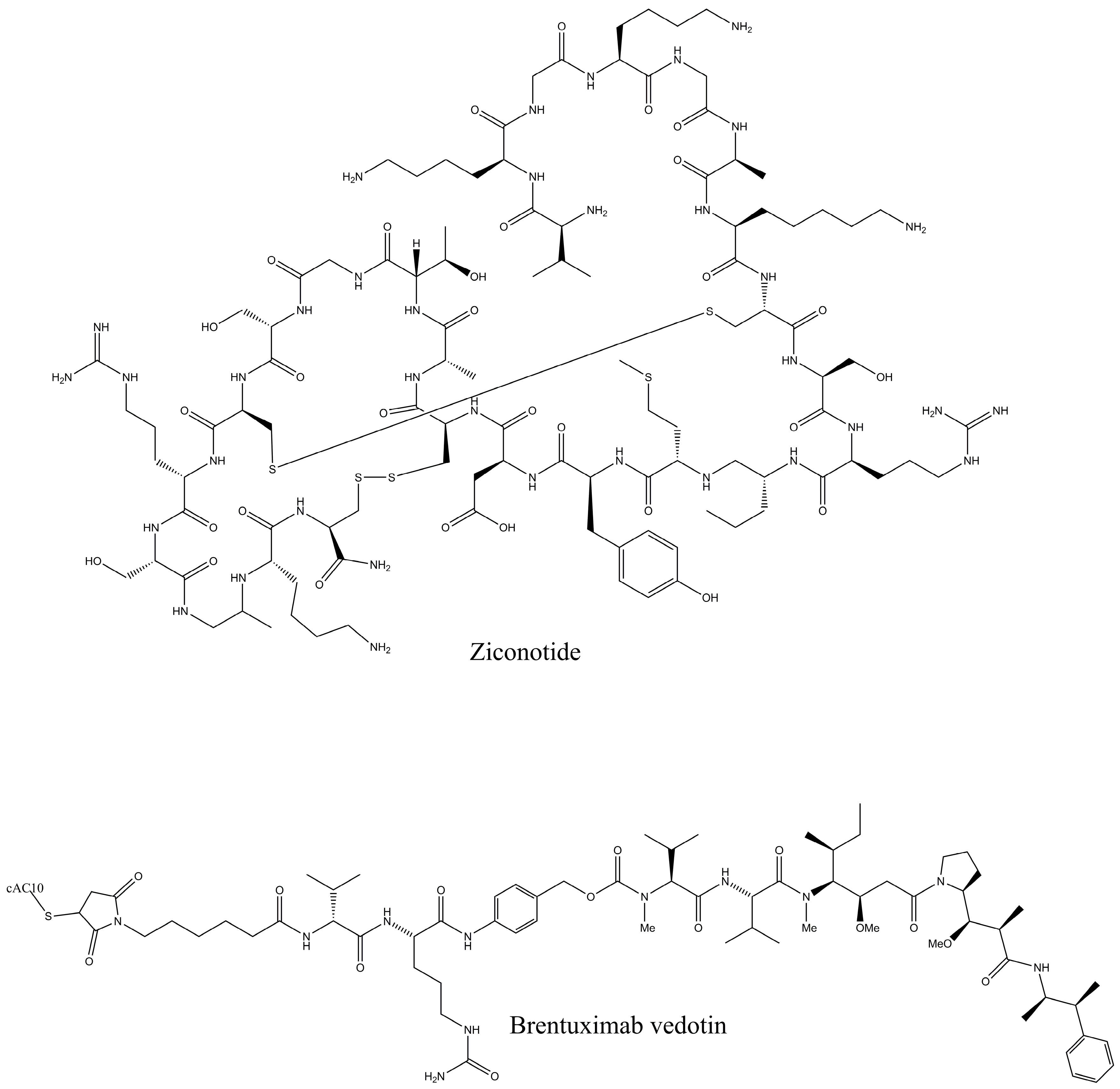
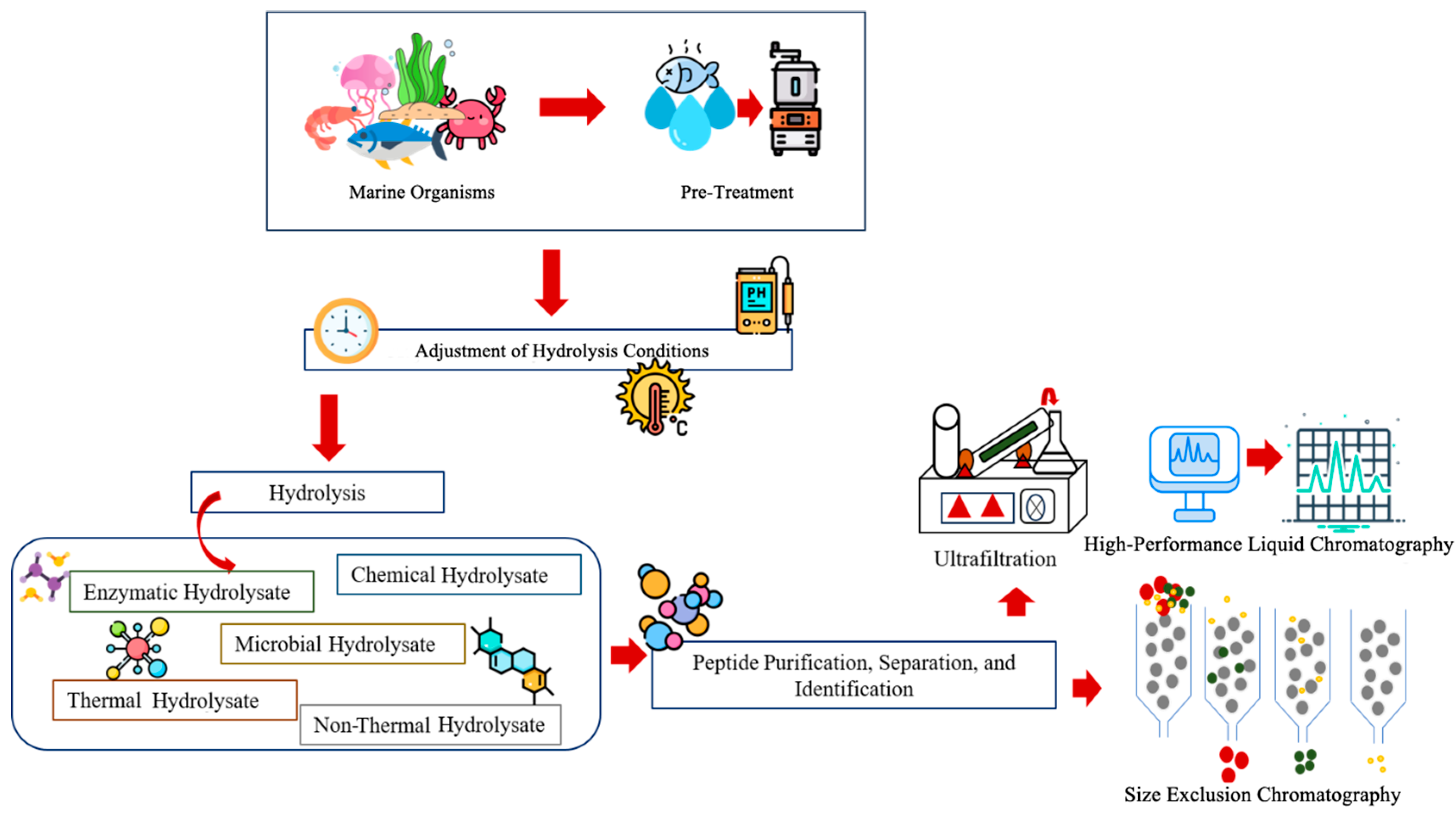
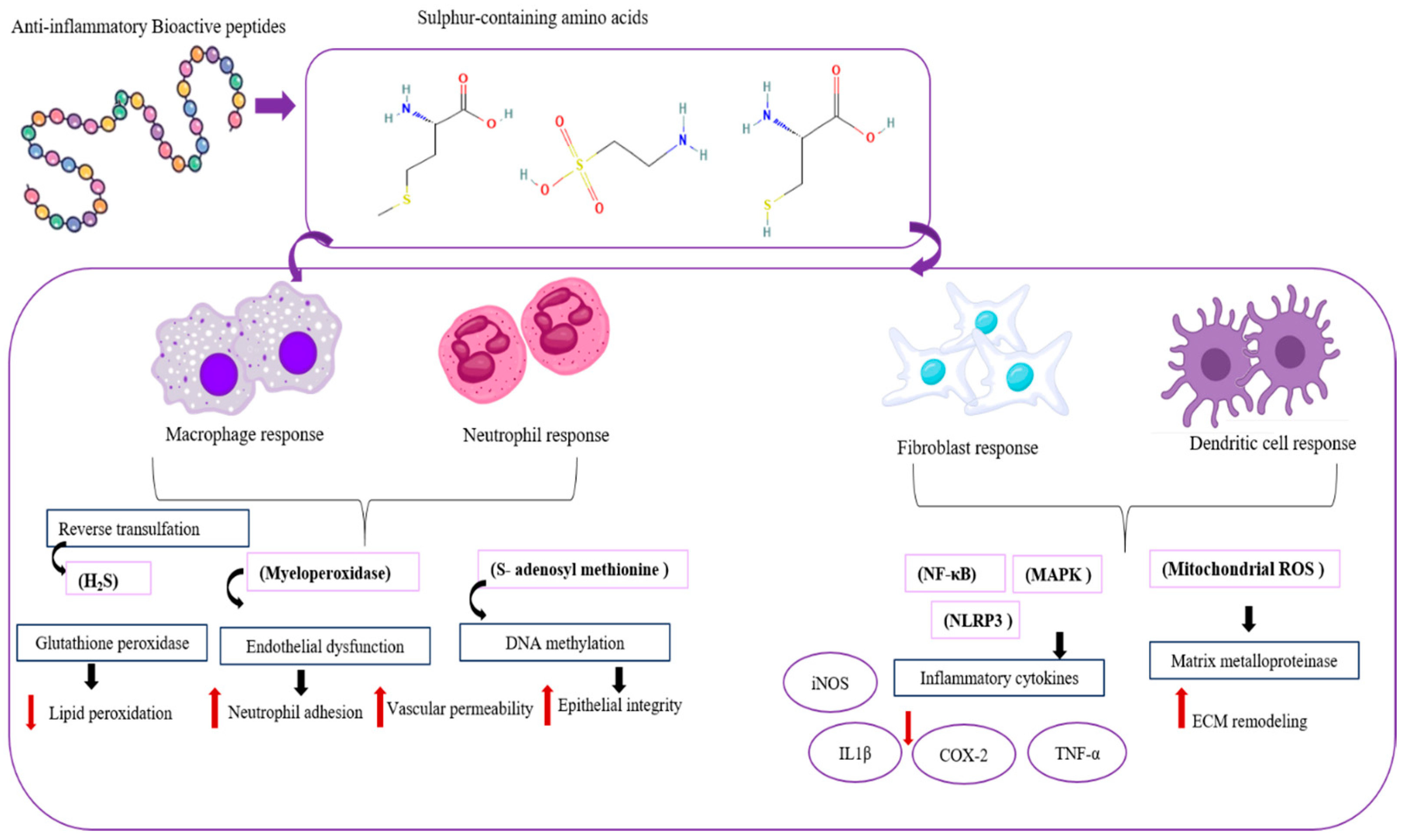
| Compound | Derivative/Natural Product | Marine Source | Application | Status | Reference |
|---|---|---|---|---|---|
| Glembatumumab vedotin | Derivative | Dolastatin 10 from Dolabella auricularia | Cancer Treatment | Phase I/II Clinical Study | [38,39,40] |
| Plitidespin | Natural product | Cyclic Depsipeptide from Aplidium albicans | Cancer Treatment | Phase I/II Clinical Study | [41,42] |
| DU145 (Soblidotin) | Synthetic Derivative | Sea Hare (Dolabella auricularia) | Cancer Treatment | Phase I Clinical Study | [43] |
| Plitidepsin | Derivative | Cyclic Depsipeptide from Aplidium albicans | Antiviral (SARS-CoV-2) | Phase III | [3,44] |
| Structural Features | Source of MBPs | Feature Highlighted | Biological Activity | Key Findings | References |
|---|---|---|---|---|---|
| MW of the marine peptide | Lophius piscatorius (monkfish) swim bladder hydrolysate fraction | <1 kDa | Antioxidant | Scavenging free radicals (51.57 ± 1.45 and 76.96 ± 2.40% for DPPH and HO) | [23,50] |
| Ulva prolifera | <3 kDa | ACE Inhibitory | High ACE inhibitory activity with low-MW peptides (IC50 = 0.036 mg/mL) | [51] | |
| Hippocampus abdominalis | <5 kDa | ACE Inhibitory | High ACE Inhibitory activity with low-MW peptides (IC50 = 0.044 mg/mL) | [52] | |
| Amino acid composition and sequence | EVPLFR from Cucumaria frondosa, RWDISQPY from Sargaddum maclurei, SEGPK, FDGPY, and SPGPW from Monkfish | Hydrophobic (Leu, Phe, Trp), aromatic at C-terminus, positively charged (Lys, Arg) in middle, Proline at C-terminal | ACE Inhibitory | Binds to the ACE active site via hydrogen bonding, hydrophobic, and electrostatic interactions | [53,54,55] |
| LLVSeMY, MMDSeML (Oyster)-GVPLT, GPP, AGLYPGA from fish sources | Aromatic (Tyr, Trp, His), sulfur-containing (Met, Cys), hydrophobic residues | Antioxidant | Scavenges ROS via electron donation (His), H-donation (Cys), or S-atom oxidation (Met) | [55] | |
| HVLSRAPR from Spirulina platensis | Hydrophobic amino acid-charged residues | Anticancer | Improves membrane interaction, enhance selectivity, and reduce cytotoxicity | [23] | |
| Spatial conformation | Turbot viscera hydrolysate from Scophthalmus maximus | High α-helical content—strong amphiphilic symmetry | Antimicrobial effect | Enhances membrane disruption and bacterial killing | [56] |
| Extraction Method | Advantage | Disadvantage | References |
|---|---|---|---|
| Conventional Solvent | Simplicity Practicality Cost-effectiveness | Prolonged extraction times Darkened protein coloration Suboptimal extraction efficiency | [62,63] |
| Microwave-Assisted | Less use of solvent High extraction efficiency | Filtration step is required Darkened protein coloration | [62,64,65] |
| High Hydrostatic Pressure | Reduction in microbial load Efficient extraction yield Reduced chemical usage | Limited industrial scalability Potential structural changes | [62] |
| Pressurized Liquid | Less use of solvent Improved extraction efficiency Excellent compatibility for food-grade purposes | High maintenance cost Potential protein degradation | [62,65] |
| Pulsed Electric Field | Higher extraction yield Maintains protein integrity Shorter processing time | High equipment cost Higher electricity consumption Limited industrial scalability | [62] |
| Enzyme-Assisted | Increased yield of extract Non-toxic Non-flammable | High cost of enzyme Difficult to scale up | [62,64,65] |
| Ultrasound-Assisted | Reduced use of solvent Lower extraction temperatures Shorter extraction time | Possible degradation of heat-sensitive compounds and formation of free radicals | [58,62,66] |
| Deep Eutectic Solvent Extraction | Numerous combinations Low toxicity Cost-effective | Prolonged extraction time Potential protein degradation | [64] |
| Physically-Aided Extraction | Increased efficiency Reduced extraction time Intact collagen structure | Limited industrial scalability Difficult steps | [64] |
| Extrusion–Hydro-Extraction | High yield Reduced waste Continuous production | High equipment cost Filtration step required | [64] |
Disclaimer/Publisher’s Note: The statements, opinions and data contained in all publications are solely those of the individual author(s) and contributor(s) and not of MDPI and/or the editor(s). MDPI and/or the editor(s) disclaim responsibility for any injury to people or property resulting from any ideas, methods, instructions or products referred to in the content. |
© 2025 by the authors. Licensee MDPI, Basel, Switzerland. This article is an open access article distributed under the terms and conditions of the Creative Commons Attribution (CC BY) license (https://creativecommons.org/licenses/by/4.0/).
Share and Cite
Gunasekara, D.M.N.M.; Wijerathne, H.D.T.U.; Wang, L.; Kim, H.-S.; Sanjeewa, K.K.A. Marine Bioactive Peptides in the Regulation of Inflammatory Responses: Current Trends and Future Directions. Proteomes 2025, 13, 53. https://doi.org/10.3390/proteomes13040053
Gunasekara DMNM, Wijerathne HDTU, Wang L, Kim H-S, Sanjeewa KKA. Marine Bioactive Peptides in the Regulation of Inflammatory Responses: Current Trends and Future Directions. Proteomes. 2025; 13(4):53. https://doi.org/10.3390/proteomes13040053
Chicago/Turabian StyleGunasekara, D. M. N. M., H. D. T. U. Wijerathne, Lei Wang, Hyun-Soo Kim, and K. K. A. Sanjeewa. 2025. "Marine Bioactive Peptides in the Regulation of Inflammatory Responses: Current Trends and Future Directions" Proteomes 13, no. 4: 53. https://doi.org/10.3390/proteomes13040053
APA StyleGunasekara, D. M. N. M., Wijerathne, H. D. T. U., Wang, L., Kim, H.-S., & Sanjeewa, K. K. A. (2025). Marine Bioactive Peptides in the Regulation of Inflammatory Responses: Current Trends and Future Directions. Proteomes, 13(4), 53. https://doi.org/10.3390/proteomes13040053







